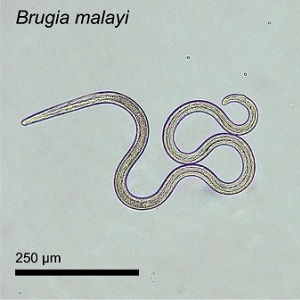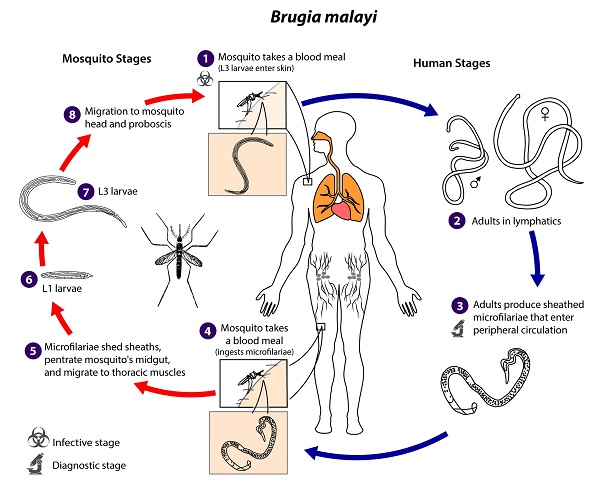Brugia timori - Introduction, Classification, History, Habitat, Morphology, Life Cycle
Introduction to Brugia timori
Brugia timori is a filarial nematode parasite which is the etilogical agent of the disease Timor filariasis or Timorian filariasis. This roundworm is arthropod-borne and inhabits the lymphatic system in humans and causes acute fever and chronic lymphedema.
Classification of Brugia timori
The classification of Brugia timori is as follows:
Kingdom: Animalia
Phylum: Nematoda
Class: Secernentea
Order: Spirurida
Family: Onchocercidae
Genus: Brugia
Species: B. timori
History of Brugia timori
In 1964, David and Edeson first described the parasite as a different species from Brugia malayi. Just a year later, in 1965, they described the microfilariae of the parasite.
In 1977, the adult worms of Brugia timori were first retrieved by Partono from experimentally infected jirds. Late in the same year, the primary vector was identified to be Anopheles barbirostris.
Habitat of Brugia timori
Brugia timori adults inhabit the lymphatic system of infected humans.
Morphology of Brugia timori
The significant morphological features of Brugia timori include adult worms, microfilariae, and third-stage larvae (L3).

Brugia timori microfilariae (Source: parasitesandvectors.biomedcentral.com)
Adult worm
adult female Brugia timori measures 3 cm in length and 10 mm in breadth
adult male Brugia timori measures 2 cm in length and 7 mm in breadth
both males and females have a bulb-like end
tail or posterior end is long and tapering
in males, the spicules are not equal and are dissimilar to each other
Microfilariae
Brugia timori microfilariae are nocturnal periodic
measures 290 to 325 µm in length and 5 to 6 µm in diameter
are sheathed which stains poorly with Giemsa stain
longer cephalic space; length-to-width ratio of about 3:1
less dense body nuclei
around 5 to 8 smaller nuclei are present at the distal part of the tail

Life cycle of Brugia timori (Source: CDC)
Life Cycle of Brugia timori
The life cycle of Brugia timori is completed in two classes of hosts – the definitive host and the intermediate host. They are nocturnal and periodic in nature.
Definitive host: Humans (no known animal host)
Intermediate host: Mosquitoes (Anopheles barbirostris)
Transmission of Brugia timori begins with the bite of infected mosquitoes onto a healthy person.
bite of an infected mosquito transmits the third-stage larvae (L3) onto the skin
the larvae enter through the punctured wound made by the infected vector and reach the peripheral lymphatic vessels
Brugia timori larvae quickly migrate to inguinal lymph nodes where they metamorphose and grow into sexually mature adult males and adult female
both adult male and female filarial nematodes live in regional lymphatic vessels and nodes (mostly in the cortex of lymph nodes and testicular tissues) as coiled-up structures
after fertilization, the ovo-viviparous female deposits microfilariae
the newly emerged microfilariae appear in the peripheral blood after a number of months
these microfilariae circulate in the blood for months to years
if these microfilariae are not taken up by the vector (mosquitoes), they die
if the microfilariae are ingested by the vector, within hours inside the vector’s stomach, they lose their sheath
within a couple of hours, these microfilariae larvae migrate to the thoracic muscles
the slender Brugia timori microfilariae larvae undergo development in the next 48 hours to molt into first-stage larvae (L1)
Between 3rd day to 7th day, the L1 larvae of Brugia timori molt to become larger sausage-shaped second-stage larvae (L2)
the L2 larvae eventually moults to third-stage larvae (L3) by the 10th and 11th day
during the infection, L3, the infective form of the parasite, migrates to the salivary glands of the mosquito vector
if the vector takes a blood meal from a healthy person, the L3 Brugia timori larvae are released from the tip of the proboscis of the infected mosquito into a new host
*development of Brugia timori larvae in mosquitoes is completed in 10 to 20 days.
* microfilariae of the filarial nematode do not undergo multiplication to increase in number i.e. only each microfilaria develops into one infective larva